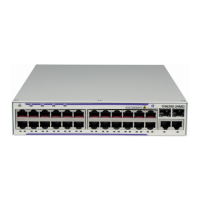Interface Configuration
7210 SAS M, T, X, R6, R12, Mxp Interface Configuration Guide Page 37
In the 7210 SAS-M and 7210 SAS-T an ingress QoS policy is applied to the aggregate traffic that
is received on all the member ports of the LAG. For example, if an ingress policy is configured
with a policier of PIR 100Mbps, for a SAP configured on a LAG with two ports, then the policer
limits the traffic received through the two ports to a maximum of 100Mbps.
In the 7210 SAS-M and 7210 SAS-T an egress QoS policy parameters are applied to all the ports
that are members of the LAG (all ports get the full SLA). For example, if an egress policy is
configured with a queue shaper rate of PIR 100Mbps, and applied to an access-uplink or access
LAG configured with two port members, then each port would send out 100 Mbps of traffic for a
total of 200Mbps of traffic out of the LAG. The advantage of this method over a scheme where the
PIR is divided equally among all the member ports of the LAG is that, a single flow can use the
entire SLA. The disadvantage is that, the overall SLA can be exceeded if the flows span multiple
ports.
LAG and QoS policies on 7210 SAS-Mxp
In 7210 SAS-Mxp, a SAP ingress QoS policy or network port ingress QoS policy or network IP
interface ingress QoS policy is applied to the aggregate traffic that enters the traffic through all the
ports of the system. For example, if an ingress policy is configured with a policier of PIR
100Mbps, for a SAP configured on a LAG with two ports, then the policer limits the traffic
entering the system through the two ports to a maximum of 100Mbps.
In 7210 SAS-Mxp, SAP egress QoS policy shaper parameters are applied to all the ports that are
members of the LAG (all ports get the full SLA). For example, if an SAP egress policy is
configured with a shaper of PIR 100Mbps, each port would get a PIR of 100 Mbps. The advantage
of this method over a scheme where the PIR is divided equally among all the member ports of the
LAG is that, a single flow can uses the entire SLA. The disadvantage is that the overall SLA can
be exceeded if the flows span multiple ports.
In 7210 SAS-Mxp, network port egress QoS policy shaper parameters are applied to all the ports
that are members of the LAG (all ports get the full SLA). For example, if an network port egress
policy is configured with a shaper of PIR 100Mbps, each port would get a PIR of 100 Mbps. The
advantage of this method over a scheme where the PIR is divided equally among all the member
ports of the LAG is that, a single flow can uses the entire SLA. The disadvantage is that the overall
SLA can be exceeded if the flows span multiple ports.
LAG and QoS policies on 7210 SAS-X
In 7210 SAS-X, a SAP ingress QoS policy or network port ingress QoS policy or network IP
interface ingress QoS policy is applied to the aggregate traffic that enters the traffic through all the
ports of the system. For example, if an ingress policy is configured with a policier of PIR

